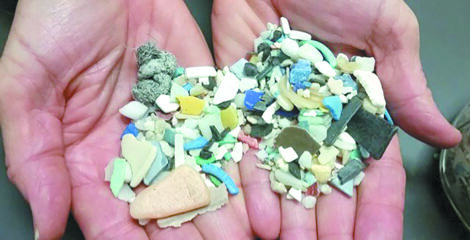Health Matters: Confusion continues regarding prescription foot supports

Dr. Conway McLean, DABFAS, FAPWHc
Why do so many people wear arch supports? They must serve some function since so many people use them. But what kind is best? There are a multitude of off-the-shelf products, in staggering variety, found in differing size and shape, mass and material. Is a prescription device always better? Questions abound.
The answers are complex and multi-faceted, as is the topic of human stance and gait. Both of these are a product of an individual’s biomechanics, meaning how (and how well) they stand and walk. And these do vary greatly person to person, as do so many components of human health.
Two specific factors are critical in the development of a majority of chronic musculoskeletal conditions of the lower extremities and spine. One is gravity, pulling us down (some more than others; weight is a factor in biomechanical issues). In particular, our bipedal nature (walking on two legs) makes us prone to a tremendous number of problems. The act of walking involves significant impact to our bones and joints, ligaments and tendons, with every step. Simply standing is stressful to many structures.
The second issue is that we, as modern humans, are on perfectly flat surfaces a great majority of the time. But the human foot was made to walk on varying, uneven surfaces. Instead, most people living in the industrialized world are on perfectly flat surfaces nearly their entire day. Consequently, any deviation from “normal” anatomy will lead to some abnormal stress or motion, repeated millions of times over the course of their lives, every time they stand or walk, from infancy to their later years.
Many Americans have purchased supports at the mall after standing on a pressure plate. The claim is this allows the selection of a more specialized device. Unfortunately, the devices dispensed by this ubiquitous foot product company are ineffective, being too soft and squishy to provide support. And a custom support should never be fashioned from this simplistic analysis. But they are. A foam box is also an inaccurate method, providing only a rudimentary reproduction of the patient’s foot contour and positioning.
To further confuse the issue, some healthcare consumers are the victims of fraud when their insurance is billed for a custom device but a stock device is dispensed instead. Some orthotic labs will use a huge collection of pre-made orthotic shells, attempting to “get as close as possible” to the patient’s foot cast. This unfortunately is not an uncommon practice and sometimes only a specialist can differentiate.
Life changing benefits are common when appropriately altering the manner in which the foot reacts to the ground. This is why practitioners expert in the nuances of human biomechanics see such significant pain relief on a regular basis. Tendons don’t become chronically inflamed when they aren’t stressed. Joints don’t degenerate if they move properly, in the right amount with proper motion. Low back muscles won’t ache if the arch doesn’t fall excessively which can lead to a change in pelvic alignment.
Like eyeglasses, foot orthotics don’t alter anatomy. Instead, they change your biomechanics and should lead to healthier function. In a way, foot orthotics bring the ground up to the foot rather than gravity pulling the body, along with the arch, downward. A common example is a foot type which experiences excessive downward motion of the arch. Reducing this can prevent the damaging consequences of this pathologic foot motion termed pronation.
Most who are prescribed foot orthotics obtain them because of pain with plantar fasciitis being the prototypical example. But surprisingly, everyone can benefit from custom support, when designed to assist in function, keeping the many structures involved in gait and stance, properly aligned. Many purchase orthotics simply to have more energy at the end of the day.
If someone has an inkling that some discomfort may be related to their foot type or biomechanics, it’s reasonable to try an off the shelf product to see if it provides any benefits. If it does, a prescription orthotic will do it better. Also important is the lifespan of off-the-shelf supports. These are effective for only a year or two, collapsing progressively, providing less and less assistance. And what are the chances you’ll pick a beneficial product out of the myriad choices on the market?
This is a critical part of our discussion: different feet need different types of support. A physician nuanced in biomechanics is going to do the most detailed and specific analysis, which generally results in the most accurate evaluation of your biomechanics. This is vital to creating the most comfortable and effective foot orthotic. But just because you are going to a podiatrist does not necessarily mean you are going to be getting the best support. This is a niche field and many individuals find it confusing. Many newer graduates stress the surgical component and even refer their patients out for foot supports.
Numerous treatments are physically, financially, and emotionally stressful. Surgery would be an obvious example. And the success rate of some operations is not particularly high. Complications are possible with any surgery and these can’t be undone. In contrast is a pair of foot orthotics. These supportive devices can function to reduce excessive motion of the arch, continuing to do so every time you put your shoes on. Their regular and recurrent use is necessary because of the repetitive nature of gait.
Regular, daily use of properly prescribed foot orthotics can provide for a healthy, well-aligned foot while weight bearing. And they can provide this optimal function with every step, five to ten thousand a day. This, in turn, will minimize the chronic stressors of abnormal biomechanical function. Experts believe many knee replacements and back surgeries could be avoided if effective foot orthotics were a more common practice. Over the years, these custom shoe inserts can preserve a large number of body parts including knees and backs. All possible simply by putting your shoes on.




